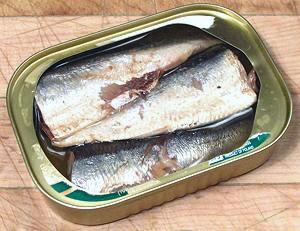 [Herring family Clupeidae]
[Herring family Clupeidae]
There are many varieties of Sardine, all members of the Herring Family, and each variety is likely to be known by a number of local names. Many millions are canned every year, packed in water, oil, mustard sauce and tomato sauce, with and without hot chilis.
Morocco is the largest producer of canned sardines in the world, providing 41% of the world's exports. Personally, I find Moroccan sardines often harsh, and prefer those canned just about anywhere else. Though the flavor is not always bad, Moroccan sardines tnd to have a lot of scales and can range from crumbly to mushy - but I've had some very good ones under the Bandi label, so it isn't all bad.
I have had excellent canned sardines from Portugal, Spain, Canada, Poland and Southeast Asia, and those I use most are from Poland. The two brands common around here are Bumblebee and SeaCliff. I prefer Bumblebee as SeaCliff are a little too mild for my taste.
Norway was once a major exporter of very fine sardines, but the major fishing and packing centers have been replaced by oil refineries since the discovery of oil and gas in the North Sea.
More on Sardines
"Brisling Sardines" are not acutally Sardines - see Sprats.
Sardines are canned by one of two methods; Mediterranean or Norwegian. In the Norwegian method the sardines are held alive until their guts are empty. They are then smoked before being beheaded. In the Mediterranean method they are beheaded and gutted. In both methods they are brined, packed in the can, steamed and drained. The cans are filled with water, oil or sauce and sealed, then heated in a pressurized retort. The cans are finally cleaned, packaged and placed in storage for flavor to develop.
There are many minor variables in both processes which will affect flavor and texture. Sardines are generally packed in "1/4 Club" (4-1/8 x 2-3/8 inch) or the flatter "Dingley" (4-1/8 x 2-7/8) cans (photo above). These typically hold 3-3/4 to 4-1/4 ounces depending on height of the can. Sardines in tomato sauce are sometimes packed in "1/2 Pound Oval" and "1 Pound Oval" cans. Drained weight is about 73% of the net weight marked on the can, depending on brand and size.
In the past, sardines were packed in a can that opened by winding the lid around a key (packaged with the can), but that type can is now seen only in cartoons. Today the cans are either "pull tab" or open with a can opener.
Usage: Sardines in sauce, most often mustard sauce or tomato sauce with or without chilis, or in oil with chili are eaten mainly as snacks, but can be used on sandwiches, particularly Scandinavian open face sandwiches. Those packed in plain oil are used in salads and spreads, particularly in Scandinavia.
sf_sardcanz 110218 - www.clovegarden.com